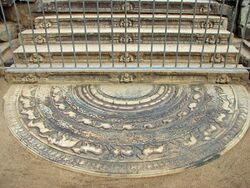Social:Sandakada pahana
Etymology
Known in Sinhalese as sandakada pahana, it is roughly translated into English as moonstone. The name is based on its shape and design.[1] The ancient chronicle Mahavamsa and Pali literature such as the Samantapasadika refer to the sandakada pahana as patika.[2]
Anuradhapura period
The first sandakada pahanas were created during the latter stage of the ancient Anuradhapura Kingdom. They were only placed at entrances to Buddhist temples during this period.[3]
The carvings of the semi circular stone slab were the same in every sandakada pahana. A half lotus was carved in the centre, which was enclosed by several concentric bands. The first band from the half lotus is decorated with a procession of swans, followed by a band with an intricate foliage design known as liyavel. The third band has carvings of four animals; elephants, lions, horses, and bulls. These four animals follow each other in a procession symbolizing the four stages in life: growth, energy, power and forbearance. The fourth and outermost band contains a carving of flames,[3] usually interpreted as representing a fire altar.
Polonnaruwa period
The design of the sandakada pahana of the Polonnaruwa period differs largely from that of the Anuradhapura period. The single band that was used to depict the four animals was removed, and processions of the elephant, lion and horse were depicted in separate bands. The most significant change is the removal of the bull from the sandakada pahana.[4] This was because in Hinduism the bull is considered as an auspicious animal and during this time of the history the influence of Hinduism was high in Sri Lanka. The Anuradhapura tradition of placing sandakada pahanas only at entrances to Buddhist temples also changed, and they are found at the entrances of other buildings belonging to the Polonnaruwa period as well.[3]
An invasion by Rajendra I in 1017 AD brought a large part of the country under the control of the Chola empire.[5][6] The country was under Chola rule until 1055 AD,[7] and the Sri Lankan culture was heavily influenced by South Indian customs and traditions, including the Hindu religion.[8] Historians believe that the reason for the removal of the bull from the sandakada pahana was because of its connection with Hinduism. The bull, the vehicle of the god Shiva, is a venerated animal in Hinduism, and therefore was removed from the sandakada pahana since it was a place where people tread upon.[4] The lion has also been omitted from some sandakada pahanas.[9] The best specimen of the sandakada pahanas of the Polonnaruwa period is at the northern entrance of the Polonnaruwa Vatadage.[10]
Kandy and Gampola periods

By the time of the Gampola and Kandy Kingdoms, the design of the sandakada pahana had changed drastically. The concentric bands were no longer there, and the shape of the once semi circular stone slab had become almost triangular. A lotus was carved in the middle of the stone slab, which was surrounded by an elaborate pattern of liyavel.[11]
Symbolism
Historians believe that the carvings of the sandakada pahana symbolise a religious meaning. The widely accepted interpretation is that of historian Senarath Paranavithana. According to Paranavitana, the sandakada pahana symbolises the cycle of Saṃsāra. The liyavel symbolise worldly desires (Taṇhā) and the lotus depicts the final achievement of Nirvana.[12] The elephant, bull, lion and horse depict birth, decay, disease and death respectively, while the swans symbolise the distinction between good and bad.[1]
References
- ↑ 1.0 1.1 Cite error: Invalid
<ref>tag; no text was provided for refs namedunique - ↑ "Buddhist Art". The Associated Newspapers of Ceylon. Archived from the original on 2009-05-04. https://web.archive.org/web/20090504044156/http://www.lakehouse.lk/mihintalava/art-05.htm. Retrieved 2009-08-09.
- ↑ 3.0 3.1 3.2 Siriweera (2004), p. 288
- ↑ 4.0 4.1 Siriweera (2004), p. 289
- ↑ Siriweera (2004), p. 45
- ↑ Wijesooriya (2006), p. 114
- ↑ Prematilleke and Karunaratne (2004), p. 6
- ↑ Siriweera (2004), p. 47
- ↑ Sarachchandra (1977), p. 129
- ↑ Prematilleke and Karunaratne (2004), p. 10
- ↑ Diganwela (1998), p. 11
- ↑ Diganwela (1998), p. 12
Bibliography
- Siriweera, W. I. (2004). History of Sri Lanka. Dayawansa Jayakodi & Company. ISBN 955-551-257-4.
- Wijesooriya, S. (2006). A Concise Sinhala Mahavamsa. Participatory Development Forum. ISBN 955-9140-31-0.
- Prematilleke, P. L.; Karunaratne, L. K. (2004). Polonnaruwa - The Silver Capital of Sri Lanka. ISBN 955-613-111-6.
- Sarachchandra, B. S. (1977) (in Sinhala). අපේ සංස්කෘතික උරුමය (Cultural Heritage). Silva, V. P..
- Diganwela, T. (1998) (in Sinhala). කලා ඉතිහාසය (History of Art). Wasana Publishers.
- Bandaranayake, Senake (1974). Sinhalese monastic architecture : the viháras of Anurádhapura. Leiden: Brill. ISBN 90-04-03992-9.
External links
 |




